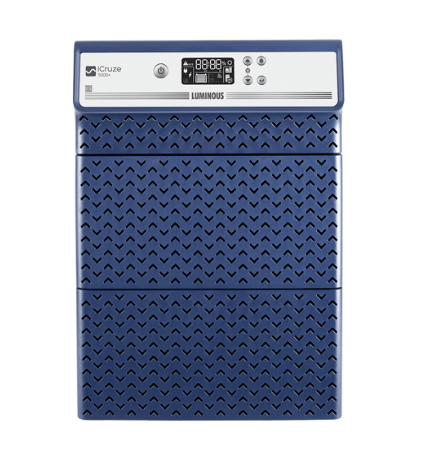
Power Solution

Selecting the right high power inverter is important for both residential and industrial settings, playing an important role in ensuring the efficient and reliable operation of various electrical devices. In residential applications, high power inverters are crucial for converting direct current (DC) from batteries or other sources into alternating current (AC) to power household appliances. The right high power inverter choice enhances energy management, providing a stable and continuous power supply to meet the diverse needs of modern homes.
In industrial settings, where large-scale machinery and equipment are commonplace, high power inverters are indispensable for converting DC power generated by batteries. The precision and reliability of these inverters are essential for maintaining productivity and preventing costly disruptions in industrial processes. In both contexts, the selection of the appropriate high power inverter ensures optimal energy utilisation, equipment performance, and overall system resilience.
Read on further to learn more about the tips to choose the right high power inverter, safety considerations, and installation tips for high capacity inverters for home.
Tips to Choose the Right High Power Inverter
Choosing the right high power inverter is crucial for reliable and efficient power conversion in various applications, such as powering appliances or tools. Here are some tips to help you choose the right high power inverter:
Power Requirements: Determine the total power (in watts) you will need the inverter to handle. Consider both continuous power requirements and peak power requirements for devices that may have a surge when starting up.
Pure Sine Wave vs. Modified Sine Wave: Pure sine wave inverters provide a consistent and high-quality power output, which is comparable to the conventional electrical grid. These inverters are highly compatible with sensitive electronic appliances. On the other hand, modified sine wave inverters are less expensive but may cause some problems with certain devices.
Size and Form Factor: Consider the physical size and form factor of the inverter. Make sure it fits in the space you have allocated for it, and consider whether it will be permanently installed or used on the go.
Input Voltage: Check the input voltage requirements of the inverter. Some are designed for 12V DC input, while others may require 24V or 48V. Choose one that aligns with your power source (e.g., car battery, solar battery bank).
Efficiency: Look for inverters with high efficiency ratings. Higher efficiency means less power is lost during the conversion process, resulting in better overall performance.
Safety Features: Look for features like overload protection, over-temperature protection, and short-circuit protection. These features enhance the safety of both the inverter and connected devices.
Cooling Mechanism: Inverters can generate heat, especially during prolonged use. Check the cooling mechanism (fans or other cooling methods) to ensure the inverter can handle the heat produced.
Remote Control and Monitoring: Some inverters come with remote controls or monitoring capabilities, allowing you to manage and monitor the inverter from a distance. This can be useful, especially for inverters installed in remote locations.
Safety Consideration for High Capacity Inverter for Home
When installing a high capacity inverter for home use, it's essential to prioritise safety to prevent accidents and ensure the proper functioning of the system. Here are some key safety considerations:
System Sizing: Ensure that the inverter capacity is suitable for your home's energy needs. Oversizing or undersizing the inverter can lead to inefficiencies and potential safety hazards.
Proper Ventilation: Inverters generate heat during operation. Ensure adequate ventilation to prevent overheating. Install the inverter in a well-ventilated area and follow the manufacturer's guidelines for clearance and spacing.
Grounding: Proper grounding is crucial for safety. Ensure that the inverter is correctly grounded to control electrical shock and reduce the risk of fire.
Isolation: Install isolation switches or breakers to disconnect the inverter from the grid or other power sources during maintenance or emergencies. This helps ensure the safety of technicians and first responders.
Emergency Shutdown: Implement an emergency shutdown procedure in case of malfunctions or emergencies. This could involve a manual shutdown switch or an automatic system that activates in response to specific conditions.
Overcurrent Protection: Install overcurrent protection devices, such as fuses or circuit breakers, to shield the inverter and the connected equipment from excessive current.
Weather Protection: If the inverter is installed outdoors, provide weather protection to shield it from rain, snow, and extreme temperatures. Use weatherproof enclosures when necessary.
Regular Maintenance: It is important to establish a routine maintenance schedule to inspect the inverter for any damage, check for loose connections, and ensure that all components are in good working condition.
Secure Your Energy Future with the Perfect High Power Inverter
By carefully assessing your power requirements and understanding the features of different inverters, you can make an informed decision that aligns with your energy needs. Whether it's for running household appliances during power outages or supporting industrial equipment, the correct sizing of your high power inverter is crucial.
Always remember to explore the diverse range of inverters available in the market. For a reliable and high-quality solution, consider checking out Luminous, a trusted brand that offers a variety of power inverters. Take the next step towards uninterrupted power supply by choosing the right high power inverter and make a wise investment for the long-term stability of your energy needs.
Source:
https://en.wikipedia.org/wiki/Electrical_grid
https://www.researchgate.net/publication/297839545_The_circuit_breaker